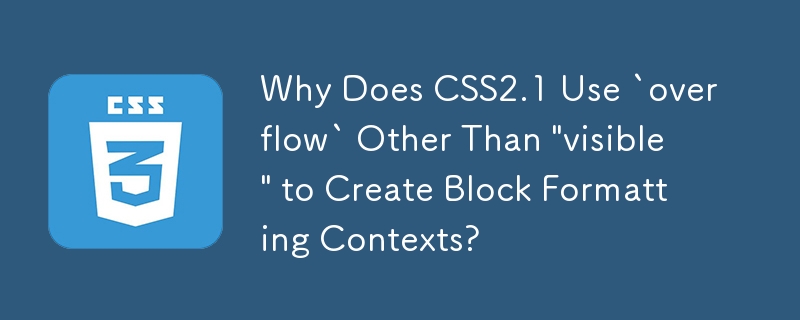 Web Front-end
Web Front-end
 CSS Tutorial
CSS Tutorial
 Why Does CSS2.1 Use `overflow` Other Than 'visible' to Create Block Formatting Contexts?
Why Does CSS2.1 Use `overflow` Other Than 'visible' to Create Block Formatting Contexts?
Why Does CSS2.1 Use `overflow` Other Than 'visible' to Create Block Formatting Contexts?
Dec 07, 2024 pm 06:10 PM
Why Does CSS2.1 Mandate Overflow Values Other Than "Visible" to Establish a New Block Formatting Context?
In CSS2.1, overflow values other than "visible" are specified to create a new "block formatting context". This decision has raised questions about the rationale behind combining two seemingly unrelated features: the creation of a block formatting context (BFC) and the suppression of overflow.
Historical Context and Key Considerations
According to inquiries made on the CSS mailing list, this decision stems from the need to address scrolling within boxes that intersect with floats. The original CSS 2.0 specification required browsers to rewrap content around intruding floats during scrolling, causing performance issues.
The CSS2.1 amendment prevents this rewrapping by establishing a new BFC for overflow values other than "visible". This ensures that:
- Content within the new BFC is not affected by floats.
- The scrolling behavior of the BFC is unaffected by the presence of floats.
Example
Consider the following example:
<div>...</div> <div> ...: ...: </div>
div {
height: 80px;
}
div:first-child:before {
float: left;
height: 100px;
margin: 10px;
content: 'Float';
}In CSS 2.0, with overflow: visible (default), the second box overlaps the floated element. However, with overflow: auto (CSS 2.1), the second box gains a new BFC, preventing the float from intersecting its content.
Implications of Overflow: Hidden
Even though overflow: hidden typically hides overflowing content, it still allows programmatic scrolling. This is important because boxes with overflow: hidden that contain intersecting floats must also establish a new BFC to prevent rewrapping during scrolling.
Changes Introduced in CSS2.1
CSS2.1 introduces additional changes:
- Block formatting context root elements (elements with overflow values other than "visible") now stretch vertically to the height of their floats.
- Boxes with overflow: hidden and height: auto are restricted by their container's bounds and can no longer intersect floats.
Consistency and Performance
Ultimately, the decision to create a new BFC for overflow values other than "visible" was primarily driven by performance considerations and a desire for consistency in handling overflowing content. This approach optimizes scrolling performance and maintains a predictable layout.
The above is the detailed content of Why Does CSS2.1 Use `overflow` Other Than 'visible' to Create Block Formatting Contexts?. For more information, please follow other related articles on the PHP Chinese website!

Hot Article

Hot tools Tags

Hot Article

Hot Article Tags

Notepad++7.3.1
Easy-to-use and free code editor

SublimeText3 Chinese version
Chinese version, very easy to use

Zend Studio 13.0.1
Powerful PHP integrated development environment

Dreamweaver CS6
Visual web development tools

SublimeText3 Mac version
God-level code editing software (SublimeText3)

Hot Topics
 Adding Box Shadows to WordPress Blocks and Elements
Mar 09, 2025 pm 12:53 PM
Adding Box Shadows to WordPress Blocks and Elements
Mar 09, 2025 pm 12:53 PM
Adding Box Shadows to WordPress Blocks and Elements
 Create a JavaScript Contact Form With the Smart Forms Framework
Mar 07, 2025 am 11:33 AM
Create a JavaScript Contact Form With the Smart Forms Framework
Mar 07, 2025 am 11:33 AM
Create a JavaScript Contact Form With the Smart Forms Framework
 Create an Inline Text Editor With the contentEditable Attribute
Mar 02, 2025 am 09:03 AM
Create an Inline Text Editor With the contentEditable Attribute
Mar 02, 2025 am 09:03 AM
Create an Inline Text Editor With the contentEditable Attribute
 Making Your First Custom Svelte Transition
Mar 15, 2025 am 11:08 AM
Making Your First Custom Svelte Transition
Mar 15, 2025 am 11:08 AM
Making Your First Custom Svelte Transition
 File Upload With Multer in Node.js and Express
Mar 02, 2025 am 09:15 AM
File Upload With Multer in Node.js and Express
Mar 02, 2025 am 09:15 AM
File Upload With Multer in Node.js and Express
 Comparing the 5 Best PHP Form Builders (And 3 Free Scripts)
Mar 04, 2025 am 10:22 AM
Comparing the 5 Best PHP Form Builders (And 3 Free Scripts)
Mar 04, 2025 am 10:22 AM
Comparing the 5 Best PHP Form Builders (And 3 Free Scripts)








